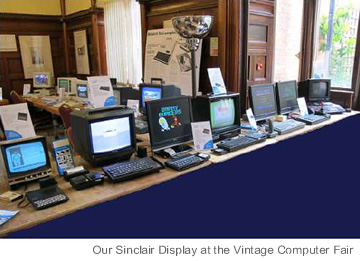Come and See Us at Spectrum 30 Anniversary in Cambridge
CAMBRIDGE TO HOST THE BIGGEST ZX
SPECTRUM 30TH ANNIVERSARY EVENT  VENUE: Anglia Ruskin University, Helmore building VENUE: Anglia Ruskin University, Helmore buildingDATES: Saturday 8th September, 10am - 6pm. Sunday 9th September, 10am – 5pm. CONTACT: web: http://www.spectrum30.org.uk/ email: jason@computinghistory.org.uk tel: 07976 774905 2012 has been a bumper year for British anniversaries with the Queen’s Diamond Jubilee, the 200th year since the birth of Charles Dickens and the 30th anniversary of a home computer from Cambridge that got generation programming and put Britain at the forefront of the video game industry, an event that will be celebrated over a two day weekend fair at Anglia Ruskin University, Cambridge near the building where it all began. Sir Clive Sinclair is probably most well known today for the commercially unsuccessful C5 electric trike, but in May 1979, his engineers began work on the machine that would give rise to the multi-million selling ZX Spectrum. Sinclair was inspired to create a home computer after seeing how much people enjoyed using a TRS-80 but realizing that many people would be put off buying one because of the high price — almost £1,250 in today’s money. To keep costs down, Sinclair met with John Grant of Cambridge-based Nine Tiles Networks to discuss developing the built-in BASIC programming language. Given the tiny budget, Grant stood to make hardly any money out of the deal, but felt the project was exciting and worthwhile, and one his company would benefit from being associated with. The kit was launched at a computer fair in the first week of February 1980, and while it was not a massive success by comparison with the ZX Spectrum, it turned Sinclair's fortunes around, eventually earning him a knighthood, and it sold well enough to persuade him to make a new computer — the ZX81. Work on the hardware had begun in September 1979, even before the launch of the ZX80, but it was the development of the uncommitted logic array, or ULA, which allowed the machine to go into production. The ULA, produced by Ferranti for Sinclair, reduced the chip count and brought the retail cost of the machine, in kit-form, down to £49.95. Again, Nine Tiles was called on to provide the software, but this time the work was handed Dr Steven Vickers, who now supervises PhD students at the University of Birmingham’s School of Computer Science. "As far as Clive was concerned, it wasn't a question of what the machine ought to be able to do, but more what could be crammed into the machine given the component budget he'd set his mind on," said Vickers in an interview in 1985. "The only firm brief for the '81 was that the '80's math package must be improved." Inspired by the public reaction to the ZX81, and annoyed at not winning the contract to design a computer for the British Broadcasting Corporation, Sinclair decided the market needed a budget colour computer. Vickers wrote the software, and the user guide, Richard Altwasser was the hardware engineer, while Rick Dickinson provided the industrial design, and thus the ZX Spectrum, known affectionately as the "pregnant calculator”, was born. Taking place on Saturday 8 and Sunday 9 September at Anglia Ruskin University’s Helmore building overlooking the former Cambridge headquarters of Sinclair Research, the 30th birthday party will feature this year’s biggest gathering of ZX Spectrum enthusiasts, with visitors travelling from countries including Denmark, Germany, Ireland, the Netherlands, Slovenia, and Spain. The show will be separated into three main areas: • An exhibition area for people demonstrating current projects, such as an Internet connection that enables Twitter users to tweet from using the ZX Spectrum. • An area for the remaining Sinclair dealers, magazines, museums and computer clubs presenting their work. • The 400 seat lecture theatre where there will be a series of presentations and guest talks. Highlights will include the obligatory performance by MJ Hibbet of "Hey Hey 16k", Roelof Koning extensive collection of ZX Spectrum clones from around the world, and a talk from veteran games industry developer Steven Goodwin on the issues of digital archeology, and a panel talk including Rick Dickinson. There will be gaming and programming competitions throughout the day, with the results shown on a large screen and visitors able to vote for the best game and best demo of the event. The event also sees the return of the ZX Microfair, originally conceived by Mike Johnston as a way for smaller manufactures to connect directly with enthusiasts. On Saturday those with Spectrums in need of repair can bring them along to the stall run by Ian Gledhill of Mutant Caterpillar Games. Other confirmed exhibitors include Rockrabilia, RWAP Software, Retro GT, the Centre of Computing History, and the Retro Computer Museum. Tickets, which include a £5 voucher for food and drink in the refreshment area, are available for individual days, priced £18 each, or both days priced £23 each. With the main events taking place on Saturday, demand is expected to be high and places are limited so booking early is advised. Arrangements are still being made and visitors are advised to check the website http://www.spectrum30.org.uk/ for up to date scheduling information. The Anglia Ruskin University website http://www.anglia.ac.uk/ provides detailed information on how to get there. Although there is no on-site car, there are park & ride parks with free parking nearby. The show is about a mile’s walk from Cambridge train station, but there are busses. Date : 29-08-2012 |









